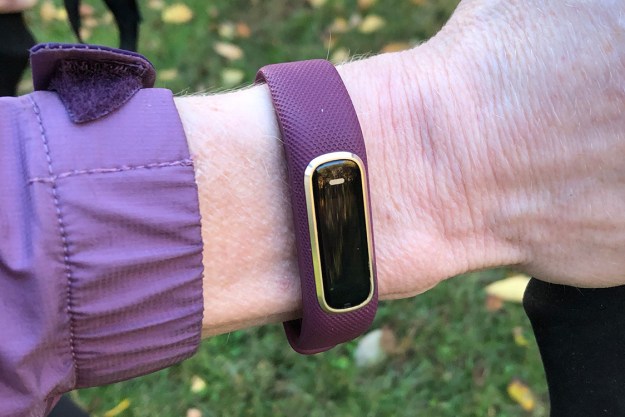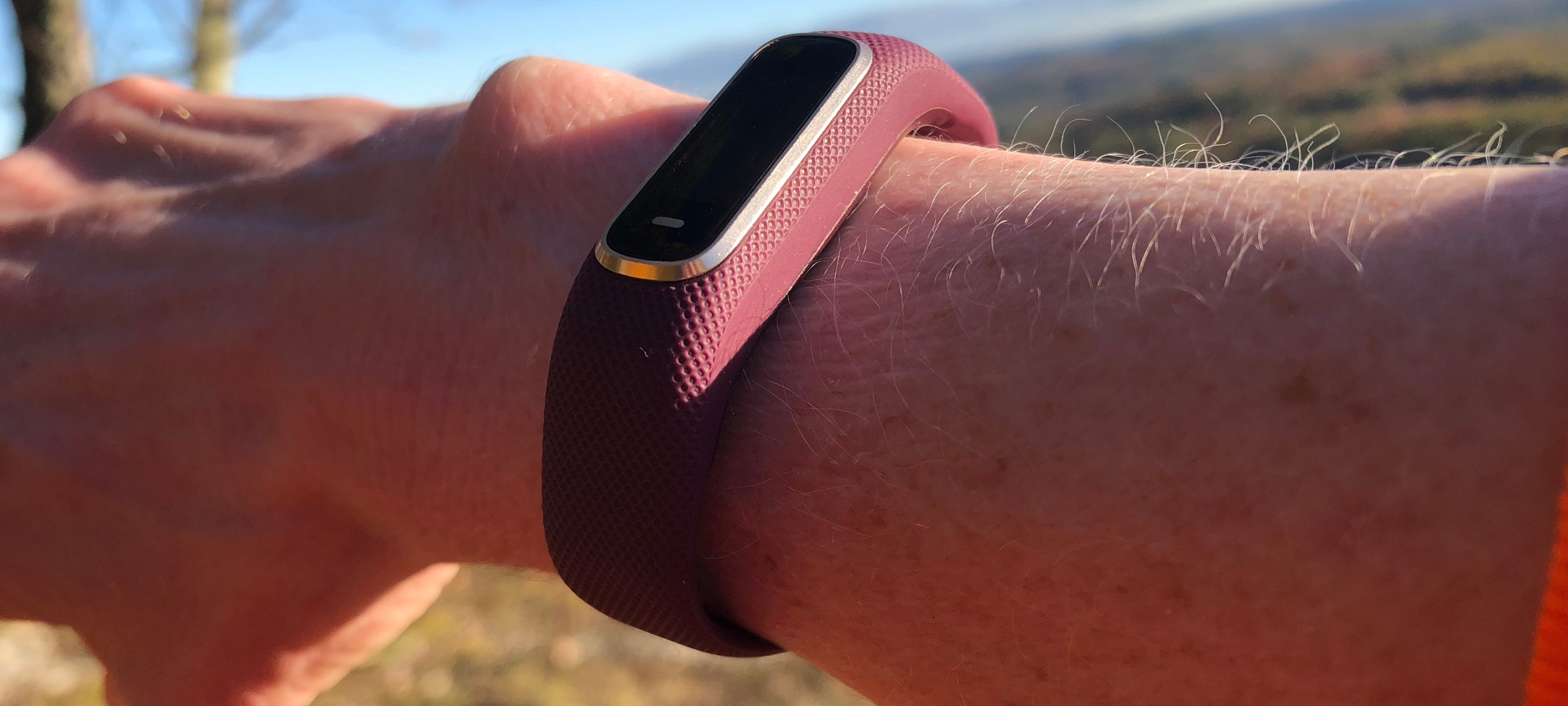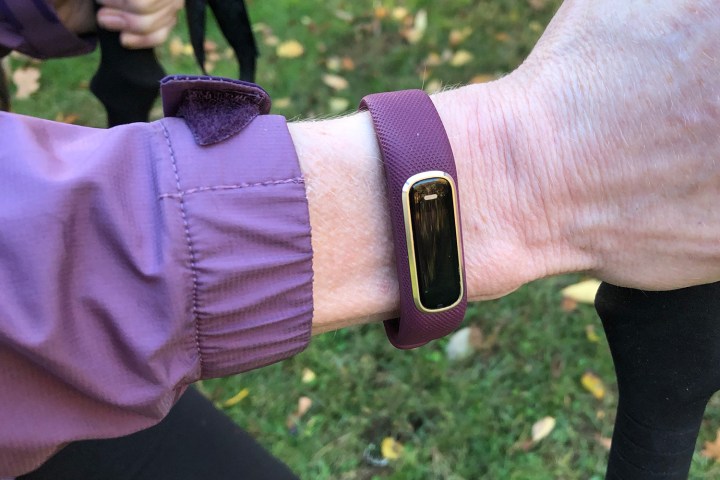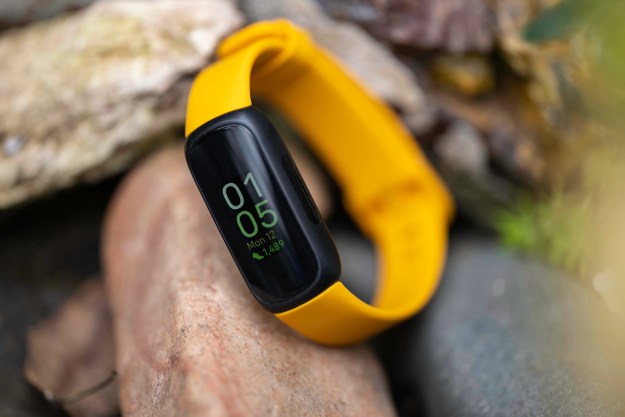
“A new style, metrics, and sensors in the Vivosmart 4 shows Garmin is willing to keep its fitness trackers fresh and exciting.”
- Slim, fashionable design
- Affordable price
- Body battery
- Pulse ox
- Small display for notifications
- No GPS or connected GPS
The Apple Watch 4 Series is our top pick for fitness tracking, earning our first-ever 5-out-of-5 stars rating, but not everyone wants the advanced metrics and apps of a smartwatch. The market for fitness-focused trackers is still alive and kicking thanks to companies like Garmin that are willing to try something new. A new style, novel metrics, and a new sensor help to set its Vivosmart 4 apart from the competition.
Stylish design
Gone are the days of clunky fitness bands that are black, boxy and look alien on your wrist. Fitbit paved the way with stylish bands, and now it is Garmin’s turn to follow. Garmin’s answer is the Vivosmart 4, one of the company’s most fashionable fitness trackers to date. The tracker unit is integrated into a slim one-piece silicone band that is slightly textured for a more pleasing look. It has a small, oblong OLED touch display that is rimmed by a thin aluminum bezel. The tracker is lightweight and extremely comfortable to wear.
The tracker unit is not removable from the band, so you are limited in your color choices. You can choose between a gray band with a rose gold bezel, a berry band with a gold bezel, a light blue band with a silver bezel, or an all-black band and bezel combination. We tested the purple-and-gold model and thought the colors were subtle and not ostentatious. They blended in nicely with both casual and business attire.
Finicky touchscreen display
Garmin packs as much as it can into the Vivosmart’s small touchscreen display, but the interface can be challenging to use. All the widgets and menu items are arranged vertically, so you have to swipe up and down to move through the options on the tracker. The interface relies heavily on icons, and it takes some time to figure out what each symbol means.
The touchscreen is responsive, but its small size can make tapping difficult.
At the bottom of the display is a touchscreen button that serves a dual purpose. When you are viewing the main watch face, this button takes you to a menu where you can start a workout, spot check your oxygen status, or access the settings. This button also serves as the back button. Just tap it to reverse through the menu until you are on the main screen.
The touchscreen is responsive, but its small size can make tapping difficult. The icons and the button on the bottom are so close together that there’s little room for error. We occasionally tapped the bottom button instead of the icon we wanted. Conversely, we had to touch the bottom button as close to the bottom of the display as possible or else it wouldn’t work. We also struggled with the double tap to start or stop an exercise. Sometimes we would double tap to begin an activity, and there was a slight lag before it would start. During this lag, we would often double tap again and accidentally pause our exercise.
Fitness and health tracking
The Vivosmart is one of Garmin’s most basic fitness trackers, but you wouldn’t know it from the spec sheet. A pulse oximeter, a wrist-based heart rate monitor, smart notifications, VO2 max estimates, and more are packed into this device. It’s not perfect, though. Garmin failed to include GPS, a useful addition that is becoming a standard feature on fitness trackers, as well as smartwatches.
Not only is there is no GPS built into the tracker, but there is no connected GPS either. You can’t use the tracker, nor the phone’s GPS to log your miles. The tracker instead uses a motion sensor to track the distance, but this estimation is hit or miss. Sometimes the measurements were close to the actual length, and other times they were wildly wrong. We used the stride-length tool to improve accuracy, and that seemed to help some of the time. If you are looking to track steps and not miles, then this omission won’t bother you. If you always want an accurate distance, then you may want to consider one of Garmin’s other trackers that include an onboard GPS.

The Vivosmart 4 may miss the mark on distance, but it excels in health tracking, with advanced metrics that are surprising given the entry-level status of the device. It includes a pulse oximeter for blood oxygen measurements and an exciting parameter known as body battery, both of which we discuss in detail below.
The tracker is focused on getting you active and keeping you active. It uses reminders to coax you to move when you have been sedentary and sends small encouragements when you have reached your fitness goals. The heart rate sensor works 24/7 to calculate your resting heart rate and your daily stress level. When you are overly stressed, you can use a relaxation timer to perform a guided breathing exercise.
Pulse ox
The Vivosmart 4 is the second Garmin fitness band to include a pulse oximeter, which measures the oxygen saturation (SpO2) of your blood. This sensor debuted in the Fenix 5X Plus GPS multisport watch as a feature for hikers acclimating to low oxygen levels at high elevation. On the Vivosmart 4, the pulse ox is used to monitor your blood oxygen levels on a daily basis and during sleep, when it could detect sleep apnea and other breathing disorders.
With the Vivosmart 4, you can take a spot pulse ox reading at any time to check your oxygen level during exercise or times of stress. During the pulse ox measurement, you have to stay as still as possible while the tracker shines red light onto to your wrist and measures how much light your blood absorbs. The tracker uses this information to calculate the blood oxygen as a percentage. Just like the Fenix 5X Plus, the pulse ox measurement was challenging to take, and we found that we hardly used it for spot checks.
We did use the pulse ox sensor to track our oxygen saturation levels automatically during sleep. On occasion, the tracker would fail to record our SpO2 readings, but for the most part we awoke each morning with a tidy graph of our oxygen saturation. We loved having this data but didn’t know what to do with it. So while this feature is cool, it’s not useful unless you have a medical professional to help you interpret what the data means.
Body battery
The Vivosmart 4 is the first Garmin device to include body battery, a unique metric that measures your energy levels throughout the day. It uses a combination of parameters including workouts, sleep, heart rate, and stress to calculate your energy reserves. The tracker monitors this metric so you are always in balance, which allows you to burn enough energy to stay fit without getting depleted. The Vivosmart offers advice to keep your “body battery charged by sleeping, taking a day off from exercise, or lowering your stress level. It’s a simplified version of the training mode found on the Fenix 5 Plus series and other hardcore fitness watches.
Body battery was by far our favorite feature on the device. We used it all the time.
Body battery was by far our favorite feature on the device. We used it all the time. The battery gauge is included conveniently as a widget on the device, making it easy to check our level throughout the day. We found that it was helpful to have this independent metric to remind us to listen to our bodies. It’s easy to ignore fatigue and push through it, but the body battery really keeps you in check. When our battery body level was low, we took a break and came out of the rest period feeling better. We hope Garmin continues to include this feature on all future fitness trackers.
Smart notifications
Like most fitness trackers, the Vivosmart 4 connects to your smartphone and allows you to view incoming notifications. Notifications can be challenging to read on the small screen of the tracker. The text will scroll so you can see the first line of the notification, but you will have to pick up your phone for more details. A feature we really like about Garmin devices is that you can reject incoming phone calls and delete alerts right from the tracker.
Battery life
Battery life is good considering how small the fitness tracker is. On average, we got four days off a single charge when we used it with the pulse ox sensor at night. Turning off the pulse ox sensor increased battery life to almost seven days.
Price, availability and warranty information
The $129 Vivosmart 4 is available now from Garmin’s website and both online and in-store retailers such as Target. Garmin fitness products are warranteed to be free from defects in materials or workmanship for one year from the original date of purchase.
Our Take
The Vivosmart 4 is Garmin’s most stylish fitness tracker, but it has more than just good looks. The tracker is packed with advanced features you wouldn’t expect to see in an entry-level device. The pulse ox sensor is helpful for people who are struggling with breathing-related issues, while body battery, our favorite feature, is an excellent metric that helps you stay fit and rested.
The biggest detractor is the lack of GPS or even connected GPS, which forces the device to estimate distance based on step count. This estimate is accurate enough for most users, but those who want accurate mileage should consider another tracker.
Is there a better alternative?
Feature-wise, the Fitbit Charge 3 gives the Vivosmart 4 a solid run for its money. The Charge 3 may not have the styling of the Vivosmart 4, but it has the performance chops. The fitness tracker has a touchscreen display, a pulse ox sensor, and connected GPS. It also is competitively priced at $149, $20 more than the Vivosmart 4.
How long will it last?
The Vivosmart 4 may be slim and lightweight, but don’t let its slim profile fool you The Vivosmart is solidly built. We used it while hiking and biking and throughout our everyday activities without any issues for over a month. The fitness band still looks like new.
Should you buy it?
The Garmin Vivosmart 4 is an excellent tracker if you don’t need distance measurements for your activities. It offers fantastic sleep tracking and unique fitness metrics that set it apart from the competition.
Editors' Recommendations
- Garmin’s newest running watch is cheaper than you’d expect
- How does Garmin measure stress, and is it really accurate?
- Garmin’s newest wearable is a big upgrade for your sports bra
- The new Garmin Lily 2 isn’t like other smartwatches
- The best Fitbit devices in 2023: 6 best watches and trackers













